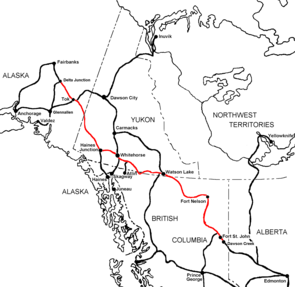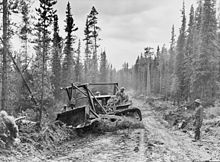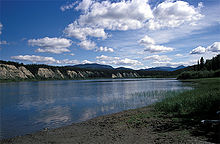Alaska Highway
| Course of the road | |
|---|---|
| Data | |
| Location: | Dawson Creek in the Canadian province of British Columbia to Delta Junction in the US state of Alaska |
| Length: | 2,288 km (1,422 miles) |
| Construction time: | March 9, 1942 to October 25, 1942 |
| Cities and places on the highway: | |
The Alaska Highway is a road from Dawson Creek in the Canadian province of British Columbia to Delta Junction in the US state of Alaska . The original name ALCAN comes from the time the road was created, is of military origin and an acronym for Alaska-Canada (military highway) . The street was officially given its current name in March 1942. At the time of completion, the highway was a pure gravel road. Since then, the road has been continuously expanded and straightened. As a result, it is around 60 km shorter than the original route today. With the exception of construction sites, it is now paved along its entire length.
An informal system of historical milestones or milestones has been developed over the years to mark important points; Delta Junction at the end of the highway accordingly has milestone 1422, which stands at the point where the Alaska Highway meets the Richardson Highway , which continues 96 mi (155 km) to Fairbanks . This section is often considered the northern section of the Alaska Highway, with Fairbanks as milestone 1523. This section is where the milestones are measured from Valdez, Alaska . The Alaska Highway is often viewed as part of the Pan-American Highway that leads to Argentina .
The Alaska Highway was added to the List of Historic Civil Engineering Landmarks by the American Society of Civil Engineers in 1995.
Building history
The first plans for a road connection to Alaska were made as early as 1930 under the US President Herbert Hoover . With the Japanese attack on Pearl Harbor in December 1941 , the vulnerability of Alaska and thus the military importance of such a road became evident . On February 6, 1942, the construction was approved by the US Army and five days later by President Roosevelt .
In March, the United States and Canada signed a bilateral right of way agreement. After that, the US took over the construction costs on Canadian territory. In return, Canada provided the building materials and waived taxes, import duties and entry formalities along the Alaska Highway. The contract also stipulated that the part on Canadian territory would become fully Canadian property after the end of World War II .
The road layout was determined by the military. It was based on existing runways between Edmonton in the Canadian province of Alberta and Fairbanks in Alaska. This chain of runways had already been used to move nearly 8,000 aircraft from Great Falls in Montana to Ladd Air Force Base near Fairbanks in the north. Of these, 2,618 Bell P-39 Airacobra machines were brought on to the Russian Eastern Front via Siberia .
The construction was driven forward with a massive commitment of people and materials. Over 10,000 soldiers were deployed. Tents, food, equipment and construction machinery had to be brought in. Work began in April 1942, starting from the two largest camps in Whitehorse and Fort St. John. The concrete course of the road was determined by existing winter roads, paths of the indigenous people, rivers and sometimes by on-site decisions based on local conditions. Since long stretches were poorly mapped, planes were also used to explore the most suitable route. Under the toughest conditions, military and civilians worked seven days a week to complete it. The main problem was replenishment.
In June 1942, Japanese troops occupied the western islands of the Aleutian Islands , Attu and Kiska. This attack made the completion of the Alaska Highway even more urgent. (See also: Battle of the Aleutians )
Driven not least by the pressure of the Japanese invasion of the Aleutian Islands, the construction crews coming from the west met those coming from the east on September 25, 1942. In October the entire route could be driven continuously. The official inauguration with the cutting of an opening ribbon took place on November 20th.
course
Note: With the introduction of the metric system in Canada in the 1970s and the changed route, the old milestones were replaced by new milestones and adapted to the changed distances. In the USA, on the other hand, the Anglo-American system of measurement is still used and the distances are based on the historical. This results in a 32 mile discrepancy on the US-Canada border. The distance information in the travel guides is mostly based on the standard publication The Milepost , which refers to the current milestones or milestones. The following distances are taken from The Milepost , 2003 edition.
- 0 km: The Alaska Highway begins at the Traffic Circle in Dawson Creek . The city is located approximately 600 km northwest of Edmonton and is named after the Canadian geographer George Mercer Dawson . It has 12,800 inhabitants and is located in a hilly grain farmland.
- Course as British Columbia Highway 2
- Course as British Columbia Highway 97
- 55 km: The highway crosses the Peace River at Taylor . The construction of this bridge was started right at the beginning of the construction work and replaced two ferries. This bridge collapsed in 1957 due to undercutting and was replaced by the current one in 1960.
- 76 km: Fort St. John was the headquarters for the eastern section. The city temporarily housed up to 6,000 soldiers and civilian construction workers. Today the city owes its wealth to the oil and natural gas deposits. With 17,000 inhabitants, Fort St. John is the last major settlement to Whitehorse, which is 1,350 km further northwest.
- 117 km: The first of the four airstrips mentioned in the historical overview, which were used for the relocation of combat aircraft to the north.
- 233 km: The so-called suicide hill was on the original highway . A sign that read Prepare to meet thy maker warned of this focus of the accident . (Prepare to face your Creator). This focus of the accident was defused by a new road layout.
- 283 km: The new street layout around Trutch Mountain , named after the first Governor of British Columbia, Joseph. W. Trutch , today saves the ascent to the formerly second highest pass of the highway with 1,260 m.
- 454 km: Fort Nelson is named after the British Admiral Horatio Nelson . The place with 4,400 inhabitants can be traced back to a fur trading station and was relocated five times.
- Stone Mountain Provincial Park
- 699 km: The road originally ran here above the picturesque Muncho Lake .
- 760 km: The bridge over the Liard River , built in 1943, is the last remaining suspension bridge on the Alaska Highway. For the next 150 km, the road runs essentially along the river. The entrance to the Liard River Hotsprings Provincial Park is also located here . Sulphurous thermal springs feed two pools, in which you can bathe all year round at water temperatures of 42 ° C to 52 ° C.
- 968 km: First British Columbia-Yukon border crossing. In the further course, the border is crossed several times.
- Course as Yukon Highway 1
- 980 km: Watson Lake , located on the lake of the same name, is a place with 1,000 inhabitants. Originally the place was called Fish Lake. The name was changed after Frank Watson, who settled here with his wife in 1898. The place became significant through the construction of an airfield, which was needed for the relocation of the aircraft to the north for intermediate refueling. Today, Watson Lake is a major crossroads and supply center in northwest Canada. From the Alaska Highway, which runs here in east-west direction, the Cassiar Highway (Yukon Highway 37) branches off to the south and the Robert Campbell Highway (Yukon Highway 4) to the north . The main attraction and landmark of the city is the Watson Lake Sign Post Forest . In 1942 brought the US soldier Carl K. Lindley (1919-2002) from Danville, Illinois, the place-name sign of his hometown at the junction to the Campbell Highway. Although this original sign was later stolen, many followed suit. By September 2003 more than 50,000 signs (mainly place-name signs from all over the world) had been installed. The further way to Teslin through the Cassiar Mountains established the bad reputation of the Alaska Highway with millions of potholes, steep inclines and deep mud holes. These have now been eliminated and the road leads through wide curves over moderate inclines.
- 1,120 km: The continental divide separates the catchment area of the Yukon River , which flows into the Bering Sea and thus into the Pacific , from that of the Mackenzie River , which flows into the Beaufort Sea and thus into the Arctic Ocean .
- 1,243 km: At 584 m, the Nisutlin Bay Bridge is the longest water-spanning bridge on the highway. The 411 inhabitants of the small settlement of Teslin on Teslin Lake are almost exclusively indigenous people of the culture of the Tlingit Indians.
- 1,297 km: The highway crosses the Teslin River at Johnson's Crossing
- 1,342 km: In Jake's Corner, the Yukon Highway 8 branches off in a south-westerly direction via Tagish to Carcross and Atlin .
- 1,404 km: The Klondike Highway (Yukon Highway 2) branches off in a southerly direction to Carcross.
- Course as Yukon Highway 1 and Yukon Highway 2
- 1,420 km: Junction to Whitehorse . The city replaced Dawson in 1953 as the capital of the Yukon Territory. The 22,975 inhabitants make up more than 2/3 of the total population of the territory. Today the Alaska Highway runs parallel to the runway of the international airport located above the city and does not touch the town center.
- 1,437 km: The Klondike Loop to Dawson turns right.
- 1,469 km: Bridge over the Takhini River .
- 1,590 km: Aishihik Road, a cul-de-sac to the lake of the same name, branches off in a southerly direction. There is Aishihik, one of the two eponymous places for the Champagne and Aishihik First Nations .
- 1,635 km: Haines Junction , a settlement with around 600 residents, is located on the Dezadeash River . The name of the place can be traced back to the road to Haines that branches off from here to the south. The places are connected by the 150 miles long Haines Road . Haines Junction is home to the award-winning Kluane National Park Visitor Center . The Kluane National Park is a place of UNESCO World Natural Heritage . In the 22,015 km² large park there is the largest contiguous glacier field outside the polar regions (for comparison Hessen: 21,114 km²). The Alaska Highway runs from here parallel to the park boundary in a northerly direction.
- Silver City
- 1,705 km: The highway crosses the A'ay Chu (formerly Slims River).
- 1,710 km: At Soldier's Summit , the road was officially opened on November 20, 1942 when a ribbon was cut. The highway now leads along Kluane Lake , the largest lake in the Yukon at 400 km².
- 1,743 km: Destruction Bay , with a population of 55 , got its name from a storm that destroyed buildings and materials during construction.
- Burwash Landing
- 1,820 km: Bridge over the Donjek River . The next 150 km to the Alaska border were the most difficult section of the entire highway because of numerous rivers, lakes and permafrost . The elders of the Kluane First Nation advised the Americans on the route.
- 1,881 km: Bridge over the White River .
- 1,935 km: Beaver Creek (112 inhabitants) is the last town on the highway before the border. Canadian border controls are already taking place here. A slope branches off to Snag, the place with the lowest temperature ever recorded in Canada.
- 1,968 km / 1190 miles (see above): The state borders of Canada and the United States.
- Course as Alaska Route 2
- 1,222 miles (1966 km): Port Alcan is the US border post.
- 1,264 miles (2034 km): In a southwesterly direction, an 18 km spur road branches off to Northway . Today 351 people live in the area of this settlement. The airfield was also a base for aircraft relocations during World War II. The Alaska Highway now runs along the Tanana River .
- 1,301 miles: The Taylor Highway leading to Eagle and Dawson branches off north.
- 1,303 miles: Bridge over the Tanana River
- 1,314 miles: Tok (1,400 inhabitants) was created during the construction of the Alaska Highway. To the south of the branches Glenn Highway leading Tok Cut-Off from.
- 1,380 miles: Bridge over the Johnson River
- 1,422 miles (2,288 km): The official terminus of the Alaska Highway in Delta Junction is marked by a memorial. Here the highway meets the Richardson Highway , which leads south to Glennallen . The road to Fairbanks heads north .
literature
- The Milepost
- the Trail of '42. A Pictoral History of the Alaska Highway. By Stan Cohen, Missoula, Montana, 2001. ISBN 0-933126-06-9 . Library of Congress Control Number 79-51360
- America's Glory Road, Richard F. Weingroff, Public Roads Autumn 2017, Washington DC 2017
Web links
Images of the Alaska Highway in the Yukon Territory, Canada
- Documentaries and feature films in the Internet Archive's holdings on the construction of the Alaska Highway






